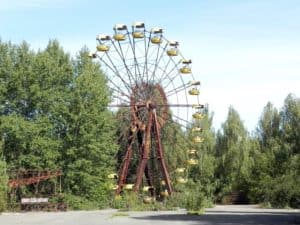 I recently returned from the trip of a lifetime and checked one of the top items off of my “bucket list.” London? Paris? Venice? No. At long last, I traveled to the Ukraine, to Chernobyl, the site of the worst nuclear disaster in history.
I recently returned from the trip of a lifetime and checked one of the top items off of my “bucket list.” London? Paris? Venice? No. At long last, I traveled to the Ukraine, to Chernobyl, the site of the worst nuclear disaster in history.
In 1986, during the Cold War when the Ukraine was part of the Soviet Union, reactor number 4 at the Chernobyl nuclear power plant exploded, launching radioactive material far and wide, contaminating most of the Ukraine and neighboring Belarus, and extending throughout Europe and the USSR, and beyond. In the immediate aftermath, finger-pointing, political agendas, and secrecy delayed evacuation, exposing local residents to severe radiation. Finally, buses carried thousands of residents off, assuring them they’d come home in a few days. They never returned, and the town of Chernobyl and neighboring city of Pripyat, constructed specifically for the power plant builders and employees, became ghost towns.
The Ukraine designated an exclusion zone surrounding the entire region with barbed wire fences, checkpoints and armed guards. This forbidden territory became my dream destination. As an avid adventure traveler and “urban explorer,” ghost towns, abandoned buildings, and post-disaster locales fascinate me. For years I knew of Pripyat, a city frozen in time, full of empty schools and homes, and even an amusement park set up for a May Day celebration that never happened. I had seen photos and descriptions online and in Atlas Obscura: An Explorer’s Guide to the World’s Hidden Wonders, as well in the horror movie Chernobyl Diaries (which turns out to have surprising accuracy, until the part when zombies appear).
I had to see this place with my own eyes. We arrived in Kiev, a delightful city, and spent several days sightseeing and eating well, with the help of Lonely Planet: Ukraine. Then met our small group of adventurers and headed two hours north to Chernobyl. Tourists may visit only with authorized guides, many signatures on liability waivers, and instructions on how to dress, behave, and use a Geiger counter. Most visitors spend a day in the exclusion zone, but we opted for the two day tour, including a sleepover in a no-frills Chernobyl hotel.
Although entering buildings is “technically” forbidden, we explored the shells of schools with kids’ books covering the floors in rooms of overturned desks, with occasional stuffed animals or children’s shoes peeking out of the rubble. We walked through abandoned gymnasiums with parquet floors caving in, dark office buildings interrupted mid-workday, and people’s homes with heartbreaking glimpses of how they lived before fleeing in a hurry. The iconic amusement park rose out of the forest, the Ferris wheel rusted but still standing, and bumper cars poised to smash although they haven’t moved for decades.
Our tour took us inside the shell of a defunct cooling tower, to the “red forest,” where Geiger counters beeped non-stop, along the top secret Soviet Duga radar, and finally up close to reactor 4 itself. For years this proximity would have caused radiation sickness, but in September 2017 construction and placement of a new “sarcophagus” was completed, covering the destroyed reactor and its inferior original enclosure, assuring confinement of the radiation for at least 100 years. A fascinating new documentary, Building Chernobyl’s Megatomb goes into detail on this project.
The explosion occurred when I was young, so I only knew the basics about Chernobyl until reading Serhii Plokhii’s timely book, Chernobyl: The History of a Nuclear Catastrophe. This 2018 definitive history delves into the origins and construction of the power plant, a nearly minute to minute account of the night of the explosion itself, and the local and global impact of what occurred. Plokhii introduces major players in the event, from laborers to politicians, humanizing them as he describes personalities and motivations, often incorporating their own words. Plokhii’s history extends through the collapse of the USSR up to the current day. I visited Chernobyl well-informed.
Do not avoid coming to the library because of the radioactive librarian! In fact, entering the exclusion zone for a limited time exposes people to little more harm than x-rays and air travel. Geiger counters alerted us of “hot spots” – certain areas or items with dangerous radiation levels: the cloth part of a discarded gas mask, the “claw” of a piece of heavy machinery that reached into the reactor in attempts to pull out its graphite rods, an industrial refrigerator beside a crate of empty milk bottles.
Believe it or not, some returned to Chernobyl after the evacuation, and a handful still live in the exclusion zone. Like residents unwilling to heed evacuation warnings due to hurricanes and fires, these individuals knew no other “home,” and would rather die in Chernobyl than live as refugees in Kiev or elsewhere. A film available to watch for free on Kanopy, The Babushkas of Chernobyl, profiles several of these residents, all elderly women, and we had the opportunity to meet one in person. Victoria lives with her dog Dana, who entertained us by singing when someone played the accordion. She served snacks and vodka and surmised that her husband died because he did not drink vodka.
Deaths from nuclear fallout prove difficult to measure. Radiation sickness does not kill instantaneously, but after days, weeks or years depending on exposure. Cancer rates and birth defects skyrocket and researchers cannot always parse out which would have occurred anyway versus which were brought on or accelerated by radiation. The babushkas somehow survive and live off the land in Chernobyl. For me, it was an incredible place to visit… but I wouldn’t want to live there.
Lydia Sampson is the Technical Services Dept. Head at the Morrill Memorial Library in Norwood, MA. Look for her column in the October 25, 2018 edition of the Norwood Transcript.



